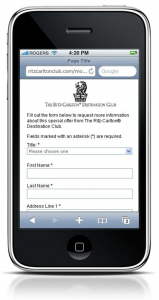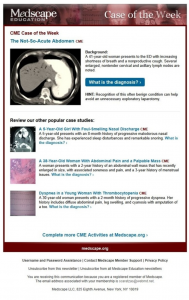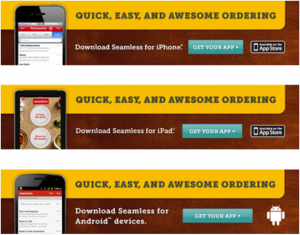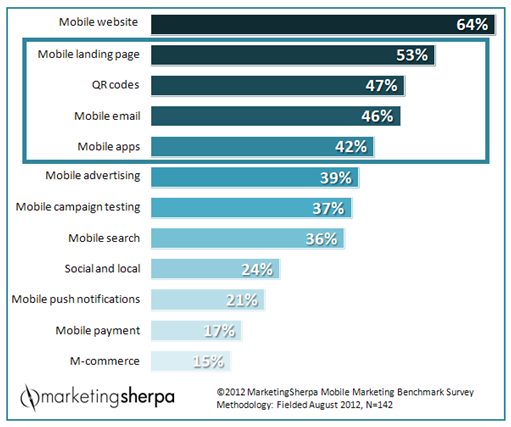Mobile Marketing: 5 takeaways from MarketingSherpa case studies
While looking through the MarketingSherpa 2012 Mobile Marketing Benchmark Report, I noticed a parallel between the top mobile tactics to be implemented within the next six months and the most recent case studies MarketingSherpa has published on mobile marketing.
Recent MarketingSherpa case studies have focused on four of the top five tactics, even touching on the top tactic, mobile website. Some marketers have started the implementation process of mobile marketing, and they have already seen great results. To help you get started on these top tactics, we pulled out the key takeaways from these case studies.
Takeaway #1: Uncover your mobile audience
No mobile user is the same. They have different habits, different objectives and different platforms. For that reason, no company should only use general or even industry standards as a single benchmark to justify its mobile strategy.
According to StatCounter, 12.3% of worldwide Web traffic comes from mobile devices, as of October 2012. But, there is much deviation depending upon the part of the world you are marketing to via the mobile channel.
To show you why it’s so important to understand if mobile is important to your audience, check out the percentages of mobile Web traffic of these five countries for August through October 2012:
- India – 52.5%
- United Kingdom – 13.04%
- United States – 10.94%
- New Zealand – 6.39%
- Argentina – 3.3%
As you can see, the country you market to makes a huge difference in whether or not mobile might be a viable strategy for your company. But, even regions of a specific country could affect your mobile audience. You might see higher mobile Web traffic in major cities where public transit is popular, especially with Wi-Fi on buses and trains becoming increasingly common in the U.S. The Massachusetts Bay Transportation Authority implemented free Wi-Fi service in 258 commuter rail coaches after finding “more than 10,000 riders are connecting to the Internet daily, through their laptops, PDAs and smartphones.”
After looking at your Web and email analytics, and determining if mobile users make up a notable portion of your audience, the next step is to determine if one browser appeals to them over the rest.
“Mobile Web browsers have different needs than traditional browsers. There are even different needs across mobile browsers as a group. A page that looks good on an iPhone will not necessarily look good on a BlackBerry,” said Adam Sutton, Senior Reporter, MECLABS, in the case study article, “Mobile Email Marketing: iPhone-targeted landing pages boost conversion rate 40% for Ritz-Carlton Destination Club.”
Here are the five primary smartphone operating systems worldwide, according to The Guardian:
- Android
- iOS
- Windows
- BlackBerry OS
- Symbian
To demonstrate how different industries, even within the same country, differ in their mobile-audience composition, let’s look at the findings of two companies from a couple of 2012 MarketingSherpa case studies.
After looking at its site analytics, the team at Marriott Vacations Worldwide discovered mobile users made up 2.8% of all traffic to The Ritz-Carlton Destination Club in Q1 2010 from email marketing. Even more interesting, while Android holds the majority market share in the U.S., iPhone users accounted for 90% of The Ritz-Carlton Destination Club’s traffic.
After analyzing detailed subscriber analytics for its more than 30 newsletters, Medscape, an online resource for physicians and other health professionals, also found its subscribers preferred Apple products – such as the iPhone and iPad. However, a larger 10 to 15% of its audience reads emails on a mobile device.
Your organization should analyze its specific audience to determine who exactly makes up its mobile audience. Knowing the specifics will allow mobile campaigns to achieve the highest effectiveness possible through customization.
Here are four questions to get you started in uncovering the breakdown of your audience:
- What percentage of our email subscribers accesses our sends via mobile?
- What mobile platforms does our audience primarily use?
- What percentage of our traffic comes from mobile access?
- At what percentage do mobile users convert, as compared with computer users?
Takeaway #2: Create mobile-optimized landing pages
Many of us have used our mobile device only to land on a webpage so difficult to navigate we immediately hightail it out of there.
Whether the page is just too large for the small screen, the buttons are too close together to push the one you want, or the Flash presentation doesn’t work on your iPhone, numerous problems could be preventing mobile users from converting on your landing pages.
That is why Marriott Vacations Worldwide decided to solve that problem for its majority iOS mobile audience.
After researching guidelines for iPhone-optimized webpages, the team designed five pilot pages for mobile users. The team included only the necessary elements on the page: the company logo, one sentence of copy, online form fields and a button to send.
The results found success: “Our typical marketing offer sees a 5% conversion rate. Our mobile landing pages for those offers saw a 7% conversion rate on average,” said Alex Corzo, Manager of Digital Strategy and Services, Marriott Vacations Worldwide.
Takeaway #3: Launch mobile version of newsletters
 After learning around 10 to 15% of its audience reads emails on a mobile device, Medscape launched mobile versions of its five most popular newsletters.
After learning around 10 to 15% of its audience reads emails on a mobile device, Medscape launched mobile versions of its five most popular newsletters.
The result? Those emails saw a 53% increase in the average unique clickthrough rate. Additionally, Medscape’s mobile audience has since doubled in size, and subscribers now spend more time reading the newsletters.
To help you learn from Medscape’s success, Adam listed the key features of its mobile email newsletter designs listed in the case study:
- Narrow, vertical format
- Above-fold content
- Fast load times and adaptable rendering
- Large fonts
- Room to click
Takeaway #4: Promote mobile app downloads via device-targeted ads
According to the MarketingSherpa 2012 Mobile Marketing Benchmark Report, 10% of surveyed marketers currently use mobile apps as a marketing tactic, but that number is expected to continually increase. In fact, 36% of surveyed marketers plan to use mobile apps as a marketing tactic in the next six months.
One way to encourage current or potential customers to download your app is through email.
For Seamless, an online and mobile food ordering company, “35% of our business on a peak weekend comes from mobile,” said Ryan Scott, VP of Marketing, Seamless.
While the team encouraged new customers to download the app in its welcome message, Seamless wanted to drive higher responses using analysis and segmentation.
Previously, the only call-to-action in the welcome message was to “get your app” in a banner at the bottom of email. This led to a landing page where visitors had to then pick one of three device types: iPad, iPhone or Android. They were then directed to the corresponding app store to download the app for the selected device.
Wanting to eliminate the unnecessary landing page step, and a potential place for lost conversion, the team created three targeted banner ads to replace the original general ad. With just one click, visitors would be taken directly to the correct app with in its app store.
Since people often use multiple devices, the team used a system that detected a reader’s platform and delivered the correct ad once they opened the email. This was the best way to ensure ad accuracy.
The targeted ads outperformed the control in split test:
- 100% higher clickthrough rate
- 120% higher share of clicks
- 35% more clicks overall
- Nearly 50% more app downloads
- 90% more orders placed after download by clickers
If you serve multiple devices with your apps, this could be a test worth trying. However, if you have yet to venture into mobile apps, Daniel Burstein, Director of Editorial Content, MECLABS, provided three basic considerations to help you with your mobile marketing efforts:
- Determine if you need a mobile app.
- If you do create a mobile app, know what to push.
- Consider ways to engage a mobile audience with collateral.
Takeaway #5: Use QR codes to create a unique experience
Nearly half of surveyed marketers (47%) plan to implement QR codes in the next six months. The codes can be used in a multitude of ways, including to encourage readers to learn more, such as in magazine ads; enhancing the user experience, for example at a museum; or providing customers instant value, such as a coupon or music download.
One company even used QR codes to create a paperless conference. Juniper Networks, a computer network company offering everything from software to systems, wanted to “show its clients how to really exploit mobile marketing,” according to the MarketingSherpa case study, “Mobile Marketing: Juniper Networks’ QR code event strategy leads to paperless conference.”
The team informed attendees and potential attendees all event collateral material, from session information to schedules to attendee contact info, would be accessible only by mobile devices using a QR reader. Juniper Networks used tutorial-styled messaging to prepare attendees for the mobile experience.
The team built a microsite designed for smartphones, but that would also render well on tablets. Attendees could watch a “welcome” video from Juniper’s senior executive for the partner community, as well as access all event materials.
The name badges even had QR codes, leading to basic contact information attendees could share while networking.
To finish the event off, Juniper used QR codes to direct attendees to an evaluation form for each session.
To receive more marketing case studies delivered to your inbox, sign up for the free MarketingSherpa Email Marketing, Inbound Marketing, B2B Marketing, and/or Consumer Marketing newsletters.
Related Resources:
Random Apps of Kindness: Using mobile for nonprofit and cause-based marketing
Mobile Social Media Marketing: 3 tips to take advantage of this growing convergence
Categories: Mobile device-targeted ads, lpo, mobile app, mobile audience, mobile newsletters, mobile optimization, QR codes











Useful information.. we always need more studies